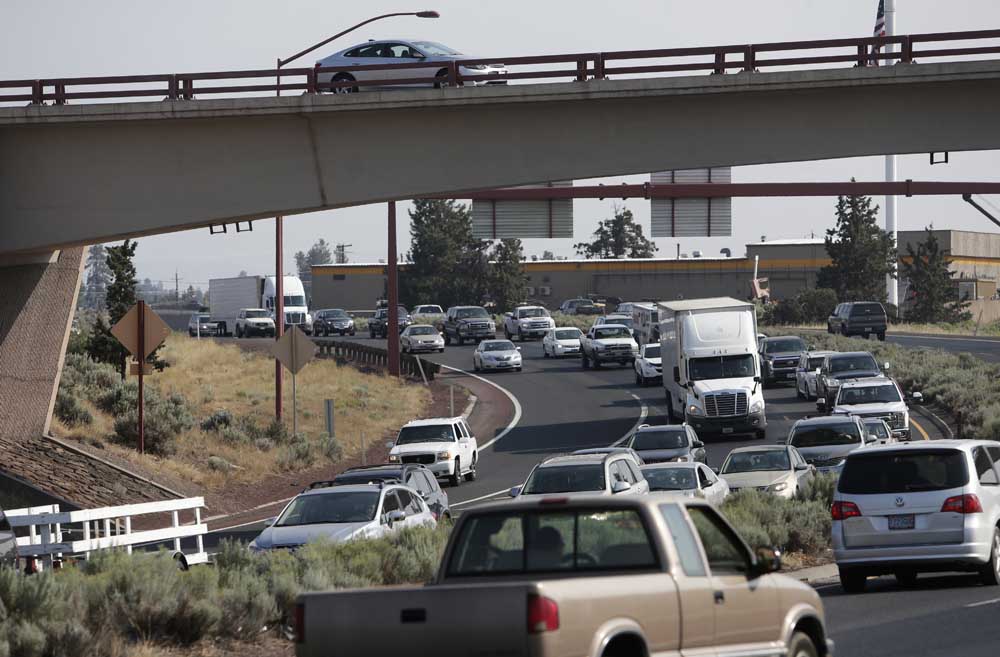Federal infrastructure plan could shift funding burden to states, cities
Published 12:00 am Sunday, February 25, 2018

- Traffic fills the northbound and southbound lanes on U.S. Highway 97 on Tuesday afternoon, Aug. 8, 2017, in Bend.
Central Oregon road officials are closely watching a federal plan that would shift the burden of paying for roads, bridges, airports and water systems onto state and local governments, but they say it’s too early to know how the region would be affected.
The White House released a much-anticipated infrastructure plan that would invest $200 billion in federal dollars over 10 years in the hopes of spurring an additional $1.3 trillion in investments from state and local governments and private builders, even while the administration’s proposed 2019 budget cuts up to $275 billion from infrastructure programs. Both are proposals, and could certainly change if and when they get through both houses of Congress.
Trending
Half of the federal government’s portion would be dedicated to matching funds for state and city projects, but on less-generous terms than they see today.
The federal government historically spent more than local governments on roads and bridges, but cities, counties and states have gradually been absorbing more costs. The White House plan would accelerate that shift, requiring local governments and/or private developers to pay for 80 percent of projects that receive federal funds.
Chris Doty, director of Deschutes County’s road department, said it’s too early to tell how swapping the portion federal and local governments pay would work. Projects that receive federal funding have to comply with stringent federal regulations, including environmental analyses and archaeological studies that add extra time and costs.
For instance, the Fall Creek Bridge replacement on Cascade Lakes Highway, which was paid for with federal dollars, was delayed a year because obsidian chips were found in the stream, Doty said.
“It’s that level of analysis that goes into a project before you can spend federal funds,” he said.
The White House plan also calls for removing or loosening some of these regulations. On the surface, the plan looks like it could provide 20 percent in federal funding to a project and 30 percent to the costs from having to comply with federal regulations, Doty said.
Trending
Under the plan, another $50 billion would be used for block grants for rural areas, and the other $50 billion would be split among other federal funds.
The Oregon Department of Transportation expected to use federal money to supplement state funding for several large Central Oregon road projects included in the state transportation package approved last summer, department spokesman Peter Murphy said. Among these are projects to improve U.S. Highway 97 to Terrebonne and the intersection of U.S. Highway 97 and Cooley Road.
While the state earmarked $50 million for improvements at Highway 97 and Cooley, a larger project to realign Bend’s congested north corridor could cost up to $250 million and would require federal support. The region has applied for a federal grant.
Historically, the region has relied on federal funding for projects including the stretch of Century Drive from the Bend city limits to Mt. Bachelor, Murphy said.
“Without federal funds, we wouldn’t be as robust as we are today,” Murphy said.
Changes to federal infrastructure spending wouldn’t have much of a visible impact at the city level, said David Abbas, director of Bend’s streets and operations department.
The city gets about $750,000 annually to preserve streets from a flexible federal grant administered by Bend’s Metropolitan Planning Organization, a regional board that oversees transportation policy in the Bend-Redmond area.
“At this point, I don’t see much of this getting down to the streets and operation level,” Abbas said.
Barb Campbell, a Bend city councilor who also sits on the Metropolitan Planning Organization board, said the plan could have the biggest impact in rural counties that have more roads funded by the state or federal government. Switching the ratio of local and federal spending could make improving those roads harder, she said.
“We are surrounded by rural communities,” Campbell said. “As long as you never leave Bend, you’ll be fine, but if you have to go through Detroit on the way to Oregon, you’ll absolutely be affected.”
The plan would prioritize grant applications for projects with non-federal revenue sources, such as local gas taxes or tolls, and it loosens rules that limit tolls on interstate highways.
Toll roads are a common sight on the East Coast, but they’re rare west of the Rockies. Oregon has none, though the state transportation package approved last year cleared the way to add toll lanes in the Portland area.
Campbell said she couldn’t imagine Oregon with toll roads.
She’s also concerned about the plan’s emphasis on private investment — right now, cities can use low-interest municipal debt or federal loans for large projects, such as roads or sewer improvements, but relying on private investors could cost governments more.
“It’s just a different way of viewing public infrastructure for private profit,” Campbell said.
— Reporter: 541-633-2160; jshumway@bendbulletin.com








